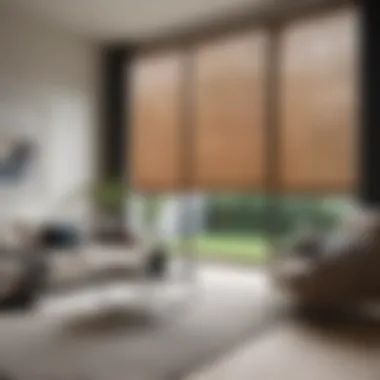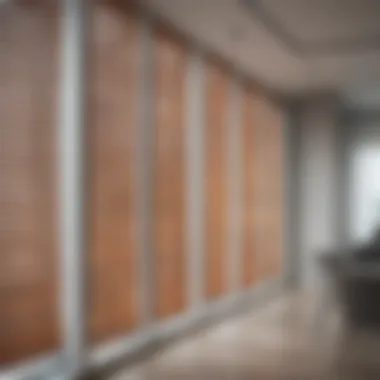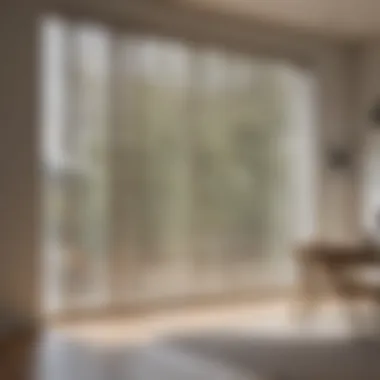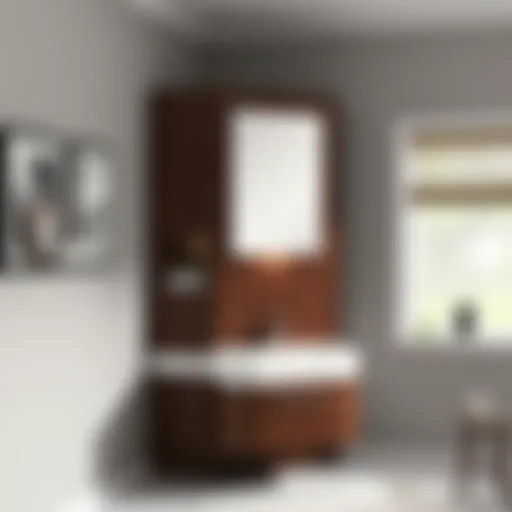Benefits and Applications of Long Blinds in Design


Intro
In today's fast-paced world, creating a comfortable and aesthetically pleasing home is more important than ever. One of the often-overlooked elements that can transform interiors is long blinds. Unlike their shorter counterparts, these window coverings offer not only practical benefits but also a unique design perspective that can enhance any space. With so many styles, materials, and functionalities available, long blinds are not just a necessity but also a design statement.
Whether you're a homeowner looking to spruce things up, a designer working on your next big project, or a DIY enthusiast eager for ideas, understanding the applications and benefits of long blinds can open doors to endless possibilities in your interior design journey.
Let's dig deeper into how long blinds serve as functional art pieces that enable a blend of light control, privacy, and energy efficiency—all while reflecting personal style.
Prelims to Long Blinds
In the realm of interior design, long blinds represent more than mere window coverings; they embody a fusion of style and practicality that influences the overall atmosphere of a space. Selecting the right window treatment can be a game changer for both homeowners and designers seeking to establish a specific mood or functionality within a room. Long blinds, particularly, stand out due to their ability to harmonize aesthetics with utility, making them a crucial component of modern decor schemes.
Understanding long blinds needs to begin with a clear definition of their various forms and how they can enhance spaces. They are designed not just to filter light but also to offer valuable features like temperature regulation and privacy. This article aims to delve into the world of long blinds, offering insights that can elevate a home’s design while highlighting practical benefits.
Definition and Overview
At their core, long blinds are window coverings that extend from the top of the window to the floor, providing a sleek and sophisticated look. They come in various materials such as fabric, vinyl, or wood, each contributing uniquely to a room’s decor. Long blinds can be articulated in multiple styles, from vertical to roller blinds, allowing for personalization to match the owner's taste. Their adjustability to control light ingress and the potential for privacy makes them versatile choices across different settings, both residential and commercial.
Historical Context
The use of blinds dates back centuries, with their origins grounded in the practicality of controlling light and maintaining privacy. Historically, various cultures found innovative ways to cover windows, reflecting their local aesthetics and available materials.
For instance, in ancient China, paper screens were used, while in Europe during the Renaissance, wooden shutters became a popular choice. It was only in the 20th century that long blinds, as we know them today, started to gain traction. The evolution from traditional fabric drapes to more streamlined vertical and roller designs exemplifies a blend of function and form, catering to the fast-paced modern lifestyle where simplicity and efficiency are key.
Types of Long Blinds
Understanding the various types of long blinds is crucial in the realm of interior design. Each type carries its own set of benefits, considerations, and styles that can significantly influence the overall aesthetic and functional attributes of a space. Long blinds can serve as more than just window coverings; they can also be a defining feature in a room, impacting both lighting and ambiance.
Vertical Blinds
Benefits of Vertical Blinds
Vertical blinds present a fantastic solution for sizable windows or sliding glass doors. One of their primary characteristics is the ability to easily control light levels, making them a favored choice for homes and offices alike. The adjustability of vertical blinds allows for fine-tuning how much light filters into the room. With a simple tilt of the slats, you can create a beautifully diffused glow or keep out bright sunlight. Not to mention, they are generally easy to maintain and suited for various decors. However, it’s important to note that they might not provide the same insulation against cold or heat as other types of blinds.
Ideal Settings for Vertical Blinds
Ideal settings for vertical blinds tend to be large windows, particularly where panels of glass meet outdoor spaces. Their unique feature of sliding open to the side makes them suitable for patios and large rooms, providing a seamless transition between indoors and outdoors. The key characteristic of vertical blinds is their versatility; they work well in modern, minimalist settings as well as more traditional spaces when paired correctly. While some may argue that they can seem dated, what they lack in trendiness, they make up for in practical functionality.
Roller Blinds
Material Options
Roller blinds are celebrated for their simplicity and sleek design. The materials used range from sheer fabrics that allow natural light in while maintaining a level of privacy, to thicker blackout fabrics that block nearly all light. This adaptability makes them a valuable choice in bedrooms or media rooms where light control is paramount. A unique feature of roller blinds is their compactness when opened; they can be rolled up neatly without taking up much space. However, fabric durability can vary, so it’s essential to consider the specific needs of your space before choosing a material.
Customization Choices
Customization is another hallmark of roller blinds. Homeowners can select from a vivid array of colors, patterns, and textures, which enhances their suitability for various decor styles. This option empowers individuals to personalize their spaces completely—be it a vibrant children’s room or a subtle adult retreat. However, the downside might be the cost, especially for custom prints or high-end materials. Ultimately, the choice of customization can make a striking difference in creating a cohesive look in home décor.
Drapery Blinds
Fabric Variability
Drapery blinds are a stylish option that brings warmth and elegance to any space. The fabrics used can range from lightweight sheers to heavy, textured materials, catering to various tastes. This variety contributes significantly to their popularity among homeowners looking to add a layer of sophistication. A unique aspect of drapery blinds is their ability to be layered with other window treatments, offering enhanced aesthetic appeal and functionality. However, they often require more upkeep than other types, as fabric can accumulate dust and stains over time.
Style Integration
In terms of style integration, drapery blinds can be effortlessly blended into various themes, from contemporary to traditional. The key characteristic of these blinds is their dramatic impact on room ambiance. By choosing the right fabric and color scheme, drapery blinds can either become a bold statement piece or enhance subtle decor. Although this style offers considerable aesthetic value, it can sometimes come at the expense of practicality, particularly in high-traffic areas.
Roman Blinds
Sophistication and Texture
Roman blinds are synonymous with elegance. Their fabric folds create a soft and inviting effect, making them a superior choice for spaces that emphasize comfort, like living rooms and bedrooms. The richness of textures available in Roman blinds can genuinely elevate the style quotient of a room. However, it’s important to note that they may require more regular cleaning due to their fabric nature. That said, they provide a classic appeal and can seamlessly integrate into a variety of settings.


Room Compatibility
When discussing room compatibility, Roman blinds shine in environments where a sophisticated touch is desired. Their versatility means they fit snugly into both traditional and modern aesthetics. The unique feature of Roman blinds is their capability to act as an elegant showcase while still being functional. While their use is often associated with more formal settings, clever pairing with casual furnishings has proven successful as well. However, their composition might limit use in damp areas like bathrooms or kitchens.
"Long blinds serve not merely as window coverings but transform a room’s entire character."
By assessing the characteristics and benefits of different types of long blinds, homeowners can make informed choices that will significantly enhance their living spaces.
Functional Benefits of Long Blinds
When it comes to choosing window coverings, long blinds stand out due to their multifaceted benefits. They do more than just block sun rays; they offer versatile light control, ensure privacy, and promote energy efficiency. Understanding these functional aspects can guide homeowners and designers alike in making informed decisions that enhance both the practicality and aesthetic appeal of a space.
Light Control
Light control is arguably one of the primary reasons why long blinds are a popular choice in various interior designs. They allow for an incredible range of adjustability, meaning that homeowners can dictate just how much light comes streaming into a room throughout the day.
Adjustability Features
The adjustability of long blinds is a game changer. Most types can be tilted, raised, or lowered with ease, allowing users to fine-tune the amount of light that enters their space. This can be particularly beneficial in a room that faces direct sunlight during certain hours, as it minimizes glare while maintaining visibility. Whether you prefer a soft, diffused light or complete darkness, the customizable nature of long blinds makes them a good fit.
Unique to many models is the cordless mechanism. Not only does this offer a clean and uncluttered aesthetic, but it also provides a degree of safety, especially in households with young children or pets. Such a feature is a noteworthy advantage, making it a popular choice among users looking for both functionality and safety.
Impact on Room Brightness
The immediate impact of long blinds on room brightness is significant. Depending on the style chosen and the way they are adjusted, they can transform a dimly lit room into a bright, airy space. The key characteristic of long blinds here is their ability to redirect natural light without sacrificing privacy.
Certain materials, like sheer fabrics found in roller blinds, offer a gentle glow that can uplift the mood in a room while keeping it private from the outside world. However, it's essential to note that not all fabrics work the same way. Heavier materials may block out light almost entirely, which can be beneficial at times but does limit some versatility in terms of ambiance.
Privacy Solutions
Finding a balance between privacy and natural light can often feel like walking a tightrope. Fortunately, long blinds excel in offering effective privacy solutions while maintaining the desired brightness in a room.
Layering Techniques
Layering techniques can be a great way to maximize privacy without compromising style. For instance, combining sheer roller blinds with blackout drapes can create a stunning visual effect while providing flexibility. Using layered curtains and blinds means you can control the amount of light entering a room while also ensuring your personal space is shielded from prying eyes.
The versatility here allows homeowners to adapt their window treatments based on their mood or the time of day. One downside might be the need for more maintenance and potential clutter from multiple layers of fabric, but for many, the aesthetic payoff is worth it.
Positioning for Effect
How long blinds are positioned can further enhance privacy levels. For instance, installing blinds higher above the window frame can give the illusion of taller ceilings while also creating a sense of seclusion without feeling boxed in. This method of positioning works wonders in small spaces and can enhance overall design flow.
This particular approach is notably advantageous in urban settings, where high-rises can encroach on privacy. Drawing the blinds at strategic heights can allow for a lovely view of the skyline while still providing a sense of privacy. However, careful consideration needs to be given to the types of blinds and their alignment, as improper installation can lead to gaps that might defeat the purpose.
Energy Efficiency
Energy efficiency is becoming an essential factor for many homeowners looking to reduce utility costs and their carbon footprint, and long blinds can play a key role in achieving these goals.
Thermal Insulation Properties
The thermal insulation properties of long blinds can either make or break energy efficiency in a home. Certain materials used in blinds are excellent at insulating windows, making them an important barrier that can keep heat in during winter while blocking it out during summer. Choosing blinds made from thick, energy-efficient fabrics can result in considerable savings on heating and cooling costs.
What’s interesting here is the option to choose from materials tailored for thermal insulation, such as cellular shades, which trap air within their cells and perform exceptionally well in temperature regulation. The only drawback might be the upfront investment for these specialized blinds; however, the long-term energy savings may easily justify the initial cost.
Seasonal Adjustments
As the seasons change, so should the management of your indoor environment. Seasonal adjustments of long blinds can add another layer of energy efficiency. In the hot summer months, keeping blinds drawn during peak sunlight hours can create a cooler atmosphere inside the house.
Additionally, in winter, adjusting your blinds to let the sun's rays in can naturally warm your home. For homeowners who value both comfort and savings, being aware of seasonal usage encourages energy-conscious choices. The flexibility of long blinds to be adjusted seasonally can contribute to more sustainable living practices; yet it requires mindfulness from the occupants to notice and adapt to such changes effectively.
Aesthetic Contributions of Long Blinds
When one thinks about interior design, aesthetics is often what first comes to mind. Long blinds are not just functional; they play a vital role in setting the mood and look of a space. Their contribution goes beyond mere appearance, affecting how a room feels and interacts with its environment. Long curtains can help tie a room together, enhancing other design elements and creating a cohesive look that pleases the eye.


Color and Pattern Selection
Trendy Color Schemes
The choice of color is paramount when selecting long blinds. Trendy color schemes can transform a dull space into a vibrant one or provide the serene backdrop that elevates a room's overall vibe. Colors like earthy tones or rich jewel shades are often favored, as they offer depth and warmth. A key characteristic of trendy color palettes is their ability to either complement or contrast existing furniture and decor, which can result in a striking visual effect.
Using trendy colors allows homeowners to make bold statements or create calming atmospheres with relative ease. It’s like painting a canvas; the right shade has the capacity to either energize or soothe. While lighter hues may open up a small space, darker options can imbue it with drama and sophistication. However, care must be taken to avoid clashes with other colors in the decor because, after all, color can either harmonize or create chaos.
Pattern Pairing with Decor
Patterns can add another dimension to long blinds, allowing them to do more than just hang elegantly. The art of pattern pairing requires a discerning eye, as the wrong mix can lead to visual confusion rather than cohesion. Floral patterns can breathe life into a space, while geometric designs might appeal to those seeking a modern edge. The key characteristic here is balance; patterns should support the room’s overall theme rather than overpower it.
For instance, pairing a vibrant paisley blind with muted furniture can serve to enhance the latter while providing a focal point. This technique can lead to delightful surprises, giving depth and character to the room. Yet, one must also consider that busy patterns can tire the eye, so it’s wise to limit their use and focus on a few statement pieces.
Texture and Material Considerations
Natural vs. Synthetic Materials
The materials used in long blinds play a significant role in their aesthetic expression. Natural materials like cotton or linen can create a soft, inviting atmosphere, while synthetic options such as polyester can be more versatile in terms of functionality and durability. A key benefit of natural materials lies in their breathable properties, which affect how light filters through them, casting serene shadows and a warm glow. However, they may require more care to maintain their form and beauty over time.
On the other hand, synthetic materials offer a more resilient option, often being resistant to fading and easier to clean. For many, the unique feature of synthetic blinds is their availability in a wide range of designs and textures, making it easier to match numerous decor styles. Yet, they can sometimes lack the organic feel that natural options provide. Knowing the unique qualities and potential drawbacks is essential, as it allows homeowners to make informed choices that align with both practical needs and aesthetic goals.
Effect of Texture on Ambiance
Texture adds depth to the visual experience. Long blinds crafted from textured materials can lend richness to a room, affecting its ambiance significantly. For example, a plush velvet blind can evoke luxury, while a simple linen option may contribute to a more relaxed, casual environment. This aspect aids in shaping the emotional tone of the space, allowing homeowners to create settings that reflect their personalities or intended use for the room.
The key here is understanding that texture can interact with light to create different moods and effects. A textured blind may catch light differently depending on its surface, leading to interesting shadows or warm reflections throughout the day. However, when selecting textures, it’s important to ensure they align with other design elements, or they risk becoming an eyesore rather than a complementary feature.
Integration in Various Themes
Modern vs. Traditional
Integrating long blinds into modern or traditional themes comes with its challenges, but also its rewards. In modern design, blinds usually feature clean lines and minimal embellishments, serving as a backdrop for other design elements. A crucial characteristic is simplicity; less is often more when trying to achieve a sleek look.
In contrast, traditional designs can embrace ornate patterns and rich fabrics. Here, long blinds can become statement pieces rather than just practical items. They contribute to creating an inviting, comforting atmosphere that aligns well with classic decor. However, the unique feature of this integration is that it requires a careful balance between modern and traditional styles to avoid visual discord.
Scandinavian and Minimalist Styles
Scandinavian and minimalist styles prioritize order and simplicity. Long blinds in neutral tones made from natural materials fit perfectly into these themes. Their ability to blend seamlessly into the surroundings is one of their main attractions. The key characteristic of these styles is functionality paired with aesthetic appeal; blinds ought to serve their purpose without overwhelming the room.
The unique feature of choosing long blinds for these styles lies in their contribution to bright and airy spaces. They allow natural light to pour in while offering options for privacy. However, a potential downside might be that overly minimalist choices can sometimes lead to a stark or cold feel, so consideration of additional textures and layers may be necessary to counterbalance the effects.
In the world of interior design, choices like color, texture, and style do not merely serve to beautify a space—they significantly influence how one feels while inhabiting it.
Understanding how to strategically implement long blinds can significantly enhance design aesthetics. They become not merely window dressings but vital contributors to the overarching theme and feel of the space.
Practical Installation and Maintenance
When it comes to long blinds, the actual installation and the ongoing maintenance can be just as vital as their aesthetic contribution and functionality. Getting these aspects right not only ensures that the blinds perform well but also preserves their look. Homeowners and interior designers often overlook these points, making installation a chore rather than a straightforward task. Knowing the ins and outs of installation and maintenance can save time and headaches down the line.
Measuring for Long Blinds
Sill vs. Ceiling Mounts
Choosing between sill and ceiling mounts can be a game changer for how long blinds fit and function in a space. A sill mount is anchored directly on the window frame, making it a favorite among many. This setup usually catches less dust, since it’s a little more accessible for cleaning, and it also doesn’t obstruct features like window sills that might be important for plants or decorations. On the flip side, a ceiling mount offers a clean, stylish look that elongates the space visually. Moreover, it provides maximum coverage of the window area, blocking out light more effectively. Knowing this context gives homeowners a clear advantage when picturing how their space will be used.
Common Measuring Mistakes
Measuring for long blinds may seem straightforward, but it’s surprisingly easy to mix something up. One of the trickiest pitfalls is neglecting to account for the width of the brackets. Many folks measure the window frame—forgetting that the brackets stick out a bit. Additionally, failing to check for uneven window frames can lead to blinds that either don't fit or look awkward. Taking the time to measure carefully can save a lot of frustration when fitting blinds into place.
Installation Procedures
DIY vs. Professional Installation


The DIY approach can be appealing for those who like to roll their sleeves up and take matters into their own hands. Cost savings are a big perk, and installing blinds can be more satisfying than paying someone else to do it. However, a pro installation often guarantees a perfect fit and saves you from potential errors. It’s crucial to weigh time against cost. If you’re comfortable with tools and measuring, you might decide to go it alone; if not, investing in a professional can save you future troubles.
Necessary Tools
No installation can occur without the right tools. Basic tools such as stud finders, levelers, drills, and screwdrivers are essential. A tape measure is a must-have; precise measurements enable a flawless fit. For those taking the DIY route, tools can often be rented from local hardware stores if you don’t own any. This option keeps costs down while ensuring you have the necessary equipment to get the job done right. Not having the right tools on hand can cause delays and frustration, so it's best to gather everything in advance.
Cleaning and Maintenance Tips
Recommended Cleaning Solutions
Keeping long blinds clean isn’t just about aesthetics; dust and grime can wear down materials over time. It’s best to use gentle cleaning solutions that won’t harm the blinds’ material. For example, a mixture of warm water and mild detergent can typically do the trick without damaging anything. Many people might reach for harsher chemicals, not realizing they can actually degrade the fabric or finish over time. Regular dusting is also essential. A microfiber cloth works wonders here.
Frequency of Maintenance
How often should you maintain those long blinds? A good rule of thumb is to check them every few months. Seasonal changes can bring dust and debris, making it important to ensure they are clean and free of buildup. This approach will help you spot any issues early rather than wait for a bigger problem to arise, such as fabric damage or mechanism malfunction. When maintained properly, long blinds can last for many years, becoming a lasting part of your home’s decor.
Long Blinds for Sustainable Living
In today's world, where eco-consciousness is on the rise, integrating long blinds into one’s living space goes beyond mere aesthetics. The focus is shifting towards sustainable living, and long blinds can significantly contribute to that movement. They not only enhance the home’s charm but also offer a myriad of benefits that align with environmental sustainability, energy conservation, and overall eco-friendliness. By choosing the right materials and embracing energy-efficient solutions, homeowners can make mindful choices that echo their values.
Eco-Friendly Materials
Biodegradable Options
When it comes to selecting blinds that are kind to Mother Earth, biodegradable options shine through. These materials break down naturally over time, minimizing landfill waste. Usually, such blinds are made from natural fibers, which brings a sense of warmth to any interior. For example, bamboo or organic cotton are popular choices. A key characteristic of these materials is their ability to blend beautifully and effortlessly with any style while offering a sustainable alternative.
A unique feature of biodegradable options is their minimal environmental impact during production. These materials often come from renewable resources, making them a popular choice among eco-conscious homeowners. However, it's worth noting that they may require more meticulous care compared to synthetic materials. Maintenance can be a bit tricky but the trade-off of lessening one's carbon footprint can be well worth the effort.
Recyclability of Materials
On the other hand, recyclability of materials plays a crucial role in sustainable living. Long blinds made of recyclable materials allow homeowners to easily dispose of their blinds without contributing to waste. For instance, aluminum and certain types of synthetic fabrics can be recycled and transformed into new products, thus minimizing environmental strain.
The key feature of these materials is their ability to be reprocessed, making them a beneficial choice for those wanting to practice sustainability in a more hands-off manner. Homeowners who prioritize recyclability can feel good knowing that their blinds will not linger in a landfill for years and years. However, an aspect to consider is the availability of proper recycling facilities and methods, which may not always be within arm's reach for some.
Energy Conservation
Reducing Heating and Cooling Costs
Energy efficiency is another critical consideration when discussing long blinds. Reducing heating and cooling costs is an undeniable perk. Long blinds can create barriers against unwanted heat during the summer and retain warmth during cold months, leading to notable savings on energy bills.
The ability to adjust these blinds for optimal insulation is a key characteristic for homeowners trying to keep costs down. For instance, using blackout blinds during winter nights can dramatically cut down heating expenses. However, it's important to remember that the effectiveness may vary based on the material chosen.
Smart Technology Integration
Lastly, a modern trend that caters to energy conservation is smart technology integration. This means these blinds can sync with home automation systems to adjust based on the room temperature or sunlight streaming in. Therefore, incorporating this technology can dramatically enhance energy efficiency and offer convenience.
The unique feature here is the ability for these blinds to respond dynamically to changing conditions, allowing homeowners to save energy without lifting a finger. Though the initial investment might be higher, the long-term savings on energy bills present a compelling case for integrating smart technology with long blinds. Plus, it elevates the ravishing of modern living, marrying functionality with innovation.
In summary, choosing long blinds that prioritize sustainability brings together practicality and responsibility. With options that emphasize biodegradable materials and recyclable attributes, along with energy efficiency and smart technology integration, homeowners can strongly step toward a greener future.
Closure
Concluding a discussion on long blinds in interior design reveals more than just the aesthetics of window treatments. It underscores how these versatile elements serve multiple practical purposes, significantly transforming living spaces. Not only do long blinds offer attractive designs, they also hold substantial functional benefits, from light modulation to energy efficiency, catering to both the whimsy of a fashionable room and the pragmatism of a well-functioning home environment.
Summarizing Key Takeaways
One of the pivotal points that emerges from the entire dialogue on long blinds is their versatility. They come in various styles, and each brings unique character to a space. Vertical blinds, for instance, suit large windows and sliding glass doors, while roller blinds can be tailored for style without sacrificing function. Their adaptability makes them fitting for any room, allowing homeowners and designers to play with textures, patterns, and colors.
Another key takeaway is the energy efficiency aspect. Long blinds can play a key role in regulating room temperature, effectively reducing heating and cooling costs. As more people gravitate towards sustainable living, the ability of long blinds to insulate a room not only cuts energy use but elevates overall comfort.
Privacy is also a crucial factor. Long blinds allow for seamless control over what comes in and out. With the right installation techniques, layering can enhance both privacy and light control simultaneously, offering a two-in-one solution for those wanting to maintain a serene atmosphere at home.
Future Trends in Long Blinds
Looking ahead, the evolution of long blinds in interior design is poised to witness exciting changes. One prominent trend is the integration of smart technology. Advanced systems that allow remote control, automation, and integration with home systems are becoming more commonplace. Imagine adjusting your blinds through a smartphone or voice commands—this functionality not only enhances convenience but can also lead to energy savings.
Moreover, trends towards eco-friendly materials are rising. As consumers become increasingly aware of environmental impacts, the demand for biodegradable and sustainable options is likely to grow. Products made from recycled materials or those that can be easily disposed of will likely see a surge in popularity among environmentally-conscious homeowners.
In the end, long blinds cater to both functional and aesthetic desires within a home setting. Their significance within interior design lies not only in their visual appeal but in their increasing ability to adapt to modern trends and individual lifestyles, making them a staple in any thoughtfully-designed space.















